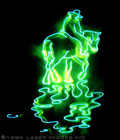|

|
|
Show
Basics: How a Laser Works |
Making Light
By
Bob Mueller, Lightspeed Design Group
http://www.lightspeed.wa.com
The word LASER is an acronym. It stands for Light Amplification
by the Stimulated Emission of Radiation. By "radiation",
however, the acronym refers to a radiant vibration, not an emission
of radioactive particles. In other words, the emissions of lasers
are in the form of light, and the frequencies can range anywhere
from infra-red to ultraviolet. Those lasers of interest to the
laser display industry, however, are mostly those whose output
is visible (from red to deep blue).
As the acronym suggests,
lasers work through a process called stimulated emission. The
lasers we typically employ are called ion gas lasers, due to
the fact that they utilize a gas or a mixture of gases as the
lasing medium. These work because certain gases are "easily"
coerced to produce visible light through this process.
The stimulation comes
in the form of electricity, which excites the atoms of the gas:
as the electrons in these atoms are given more energy, they tend
to jump to a higher orbit. These unnaturally high orbits, however,
don't last long, and the electrons fall back to their proper
orbital shells, to be once again excited by the influx of electricity.
It is this process of the electrons returning to their original
orbits that creates the laser light we see (actually, it's more
appropriate to call it a jump, for an electron falls from orbit
in a span of time infinitesimally small): During this jump back
down, the extra energy is released from each atom as a packet
called a photon (light). Moreover, if this photon collides with
another already excited atom, that atom is also stimulated to
emit a photon...but this new photon will be vibrating perfectly
in step (in-phase) with the colliding photon, and will be traveling
on the exact same course.
Photons are released,
however, in haphazard directions. In order to get them aligned
into the tight beam of light with which we're familiar, the tubes
in which the atoms of gas are excited must be mirrored on both
ends. Any photon that now happens to randomly travel exactly
perpendicular with the mirrors on both ends (which inevitably
happens) will cause a remarkable chain of events: The drama begins
with the photon's 'cloning' when it bounces off the mirror and
collides with another excited atom. Those two in-phase photons
then collide with two more excited atoms, making four photons
traveling in-phase, and exactly down the length of the laser
tube. This process is then repeated in a geometric progression
of photons parading exactly down the laser tube, colliding with
more excited atoms, creating more photons, reflecting off the
mirrors, and repeating and amplifying the process over and over
again.
The laser light we
see is finally released through the front mirror, whose reflective
coating was designed to be partially transparent. In this way,
a small percentage of those perfectly aligned photons is allowed
to escape, forming the thin, straight, coherent, and beautiful
beams we call LASER light.
Different colors of
light, as specific frequencies, are produced by different gases.
Argon gas, for instance, produces colors ranging from emerald
green to beautiful deep blues. Krypton gas produces a palette
from deep reds to light blues. A laser incorporating a mixture
of these two gases can produce all the colors unique to those
individual gases... simultaneously. It is these Krypton/Argon
mixed-gas ion lasers that are typically utilized in laser projection
hardware.
To sum up, laser light
provides a quality of light unmatched by any other light source
in the world: It's coherent, meaning again that the waves of
light are vibrating perfectly in step with each other (in-phase);
It's monochromatic, meaning that only very pure, specific frequencies
(colors) of light are created (though several frequencies can
be created simultaneously with the same laser); and it's low-divergent,
meaning it keeps its power contained within a narrow, barely
widening beam.
But there's something
more, as well: Synergy. The above qualities together, somehow
provide more than merely the sum of their parts. In human emotive
terms, laser light has a sparkle. Its radiance, its breathtakingly
pure, glowing colors, and its sheer elegance somehow imbue it
with an intangible, almost magical power to plug directly into
our emotions. Its synergistic qualities reach out to us in a
way we do not comprehend, and we are touched by this uniquely
wonderful lightform.
Indeed, we are drawn to it like a moth to the moon...
Bob Mueller is
art director for Lightspeed Design Group and past winner of ILDA's
Career Achievement Award.
Additional
Show Basics Links:
|



Images from top:
Laser Images, Inc.,
Laserland GmbH,
Laser Systems Europe
|